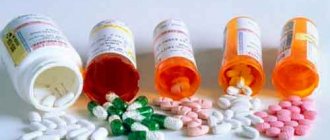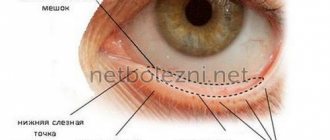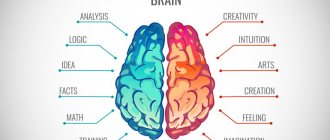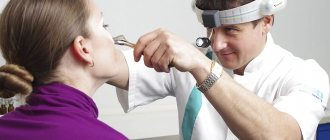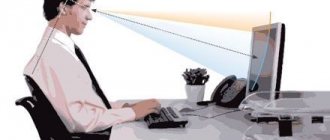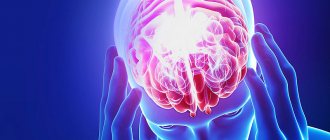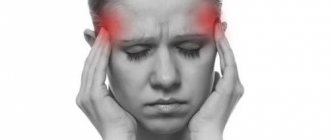Reasons why the left side of the head hurts
Headache on the left side can be caused by various reasons. It does not necessarily occur in diseases - painful sensations can also appear in healthy people due to stress or fatigue. Doctors at the Clinical Institute of the Brain advise you to go for an examination if the pain continues for more than 2-3 days in a row or bothers you too often. It is impossible to determine the exact cause at home or during a simple examination, but the doctor will need information about how the pain began, how long it lasts, in what area it occurs and with what intensity.
Physiological reasons
Even a healthy person, without any disorders or chronic diseases, can have a headache in the left area. If this symptom occurs once, is not very intense and goes away quickly, including after taking painkillers, there is no reason for concern. However, it is important to understand what can trigger a headache attack on the left side of the head in order to avoid such manifestations.
- Intense physical activity is the reason for accelerating blood circulation and activating the central nervous system. As a result, symptoms such as headache, dizziness and dark circles before the eyes, shortness of breath and tingling in the heart area may appear. To relieve them, a good rest is often enough; if the left side of your head hurts badly, you should take a painkiller tablet.
- Stress is one of the most common headaches. They arise as a result of increased concentrations of the hormones adrenaline, cortisol, angiotensin and others. They provoke vasoconstriction and increased blood pressure. To relieve pain, it is recommended to rest and resolve stressful situations, otherwise dangerous consequences are possible: chronic headaches, increased risks of stroke.
- Prolonged mental stress, including working at a monitor without breaks, can cause severe pain in the left area of the head. Constant concentration and tension, especially in a sitting position, is dangerous to health. Doctors recommend taking breaks of at least 5-10 minutes every hour and doing a light warm-up.
- Abuse of tonic drinks, which include tea and coffee, is one of the reasons why a healthy person may have a headache. They contain substances such as caffeine and tannin. These are plant components that cause a constriction of the blood vessels that supply the brain. This effect is often accompanied by an increase in blood pressure.
- Alcoholic drinks in large quantities are not a cure for headaches, but the cause that causes them. Ethyl alcohol first dilates blood vessels, and then provokes their sharp narrowing. Jumps in blood pressure are accompanied by pain, weakness and impaired heart function.
- Smoking is a source of nicotine, as well as hot vapors of other harmful compounds. This habit provokes the development of atherosclerosis, in which the lumen of the arteries narrows and they cannot supply enough oxygen to the brain. In addition, smokers often suffer from high blood pressure.
Most of the factors that cause pain in the left hemisphere of the head in a healthy person are related to habits and lifestyle. Doctors recommend completely giving up bad habits and spending time relaxing and walking in the fresh air. As a result, you can notice a significant improvement in your well-being and get rid of headaches.
Pathological conditions in which the left side of the head hurts
Pain on the left side of the head requires examination if it occurs frequently and is of high intensity. There are a number of reasons that can cause this symptom. These diseases can progress, so at the initial stage it is important to determine their cause and select an effective treatment regimen.
Migraine
An acute headache that occurs for no apparent reason and is highly intense is a migraine. During the examination, no functional impairment is observed, but it is known that this type of pain on the left side of the head is vascular in nature. Symptoms last from 4 hours to 3 days, and a migraine aura appears before the attack begins. It includes typical symptoms:
- nausea and vomiting;
- increased sensitivity to light, smells, auditory and tactile stimuli;
- numbness or tingling sensation on the skin of the face and hands;
- decreased visual acuity.
Statistically, women are more likely to suffer from migraines. Despite the fact that its primary cause has not been discovered, each patient has his own factors that can trigger another attack. This could be certain smells, foods, alcoholic drinks, extreme fatigue or stressful situations. You can relieve symptoms with painkillers, but they are not effective enough for migraines.
Tension headaches
Tension headaches are often symmetrical, but can also occur only on the left side. This is a complex of symptoms that develops due to stress, chronic fatigue, and muscle tension in the neck. One of the reasons why pain in the left head can occur on an ongoing basis is injuries in the cervical spine. The patient is concerned about characteristic manifestations:
- compressive pain that covers the temple and back of the head, spreading to the area behind the eyes;
- muscle tension in the neck and shoulder girdle;
- Symptoms increase towards the end of the day.
To get rid of pain in the head on the left, it is recommended to monitor your posture. Massage therapy can also help, but should be performed by an experienced professional, especially if there has been previous injury in the area.
Cluster headaches
Cluster headaches are considered the most intense and can significantly affect the patient's daily life. They arise in one part of the head or spread over its entire surface, often affecting the area behind the eyes, forehead and temple. Additional signs also appear:
- nasal congestion, difficulty breathing;
- ptosis - drooping of the eyelid;
- increased sensitivity to light in one eye, watery eyes;
- redness of the facial skin, increased sweating.
Cluster headaches are one of the rarest types. Their exact cause is unknown, but they often occur at regular intervals, in spring or autumn. The attack lasts for 5-10 minutes, and then the pain becomes less acute and persists for up to 3 hours. A characteristic sign of cluster pain is that it begins every day, at a certain time, for 1–3 months.
Diseases of the cervical spine
Pain in the left hemisphere of the head can be caused by diseases of the cervical spine. Here pass important vessels and nerves that carry blood and impulses to the brain. Their compression or inflammation leads to acute headaches, including unilateral ones.
- Osteochondrosis is a chronic disease in which degenerative changes occur in the cartilage layer between the vertebrae. They become less durable and elastic, and therefore lose their ability to absorb shock during movement. The space between adjacent vertebrae narrows, which leads to compression of blood vessels and nerves. Soreness manifests itself after a long stay in a sitting position or after exercise.
- Displacement of the vertebrae is a dangerous condition that leads to acute pain, inflammation of the nerves and compression of blood vessels. Most often this condition is associated with injuries, falls, or increased stress on the neck area, but in some patients the displacement can also occur in a calm state. In this case, congenital instability of the vertebrae and weakness of the neck muscles are important.
- Protrusion - protrusion of the intervertebral disc, the initial stage of a hernia. The process is accompanied by acute pain in the neck and one part of the head; any movement is difficult. The diagnosis can be made based on analysis of x-rays. The pain in the left hemisphere of the head goes away if the integrity of the spinal column is restored and the compression of blood vessels and nerves is relieved.
Chronic neck diseases require timely treatment as they can progress. The Clinical Institute of the Brain has all the conditions for a full diagnosis, as well as treatment and recovery from injuries, osteochondrosis, vertebral displacement and intervertebral hernias.
Atherosclerosis
Atherosclerosis is a chronic vascular disease that occurs when fat metabolism is impaired. Some products, including cholesterol, are not excreted, but accumulate in the blood and settle on the walls of the arteries. The vessels become fragile, insufficiently elastic, and cannot fully narrow or expand in response to increases and decreases in pressure. There are a large number of factors that can lead to the development of atherosclerosis, including:
- frequent consumption of fatty foods of animal origin (the main source of cholesterol);
- disruption of the secretion of enzymes that are involved in fat metabolism;
- liver diseases;
- overweight and sedentary lifestyle;
- smoking and alcohol abuse.
With atherosclerosis, a headache may occur on the left or right due to impaired blood supply to the brain. Painful sensations are often associated with increased blood pressure. The inability of the blood vessels to dilate and compensate for this condition leads to acute pain, dizziness, nausea and other alarming symptoms.
Traumatic brain injuries
Pain in the left hemisphere of the head can appear even long after injury. Concussions, bruises, open and closed craniocerebral injuries cause disruption of the blood supply to certain areas of the brain. Even in patients whose nervous activity is completely restored, pain may be felt after exercise and due to changes in weather. Injuries often trigger chronic migraines. The pain can be relieved with painkillers, and the doctor will help you choose the most suitable option.
Stroke
An acute headache on the left side of the head is one of the first signs of a stroke. In this condition, a sudden disruption of cerebral circulation occurs, resulting in areas of ischemia. The process can be determined at home, but it is important not to miss its first manifestations:
- acute headache, often one-sided;
- increase or decrease in blood pressure;
- pain in the heart area;
- asymmetry of movements of facial muscles and limbs;
- loss of consciousness.
The most common type is ischemic stroke. It occurs when there is an acute disturbance of cerebral circulation due to vascular disease or blockage. Atherosclerosis, stress and other factors can lead to an attack. Hemorrhagic stroke is less common, but is more life-threatening. It is accompanied by rupture of the vessel and the release of blood into the brain. It can accumulate in the brain ventricles or meninges, thereby provoking the appearance of areas of necrosis. Help for a stroke can only be obtained in a hospital, in an inpatient setting. Doctors at the Clinical Institute of the Brain emphasize that the highest probability of a favorable outcome remains if you seek help in the first 2 hours.
Neoplasms in the brain
Tumors and cysts can cause acute headaches, including unilateral ones. Neoplasms disrupt the processes of cerebral circulation, compress blood vessels and nerve tissue. The pain is chronic and always appears in the same area, but can spread to the entire surface of the head. The diagnosis is made based on CT or MRI data, and treatment tactics are selected individually. Early diagnosis of lumps is important because over time they can grow in size and cause more dangerous symptoms.
Colds
Colds and flu are common infectious diseases that appear more often during the cold season and in the off-season. The virus infects the upper respiratory tract and causes a persistent increase in temperature. Headache is also considered one of the characteristic symptoms. It is associated with pressure changes, high temperature, and also with the accumulation of exudate in the nasal sinuses. It decreases after rest and taking antipyretic drugs.
Arterial hypertension
Increased blood pressure is one of the main causes of headaches in the left area of the head. With hypertension, it is one-sided, pulsating, and can spread to the temple area or the back of the head. At home, you can measure your blood pressure using a tonometer. Normally, the result is about 120/80 mmHg; hypertension can be considered when the result is 140/90 mmHg. and more. An attack of hypertension may also be accompanied by additional symptoms:
- tinnitus, temporary deterioration in hearing and vision;
- rapid heartbeat;
- redness of the facial skin;
- painful sensations and discomfort behind the sternum.
Attacks of hypertension are often triggered by intense physical activity, stress and nervous tension. They appear more often in hot weather and in poorly ventilated areas. The pressure increases due to the need to increase the supply of oxygen to the cells. To normalize blood pressure, it is recommended to ventilate the room and take medicine.
What to do if a symptom occurs
As mentioned above, there are many reasons why pain on the left side of the head and eye may occur. However, you can’t just fight the symptom with painkillers. It is important to understand that pain is just a sign indicating a disorder in the body.
The first step is to identify the root cause of symptoms such as pain in the eye and head on the left side.
To do this, you need to visit a specialist who will help you correctly diagnose the body and then choose the right therapy. If the reason lies in colds, you need to visit an otolaryngologist who will prescribe antiviral drugs and antipyretics if necessary.
After the prescribed course of treatment, the patient should feel relief, pain in the head and eye area should disappear.
If there are problems with any part of the spine, you will need drugs with warming properties, this could be a patch with mustard or other drugs in the form of ointments and gels for external use. These methods treat the initial stages of pathology development. In cases where such therapy does not provide the desired relief, the specialist will prescribe injections and physiotherapy. Additionally, massage and physical therapy may be prescribed to improve blood flow, after which the headache disappears.
If painful manifestations are associated with migraine, you should visit a neurologist who will prescribe medications that restore normal vascular tone and normalize metabolic processes.
Methods for diagnosing pain in the left hemisphere
To determine why the left side of your head hurts, you will need a full examination. Neurologists diagnose diseases that can lead to this symptom. According to their recommendations, a number of examinations are carried out, the results of which can be informative in determining the cause of the headache and making a diagnosis:
- collecting medical history data - it is important for the doctor to know about the conditions for the occurrence of headaches, its nature and strength, as well as the patient’s lifestyle and habits, old injuries and diseases;
- Ultrasound examination of cerebral vessels (Dopplerography) is a method by which you can evaluate the speed of blood flow and the degree of filling of blood vessels;
- encephalography is a technique that allows you to examine the functional activity of the brain;
- MRI is one of the main diagnostic methods, more often used to identify tumors, but it is also informative for other pathologies.
At the Clinical Brain Institute you can undergo a full examination and determine the cause of your headache. The test results will show a complete clinical picture, on the basis of which it will be possible to select an individual treatment and prevention regimen.
Symptoms and course of the disease
When you have a headache on the left side and radiate to the eye, the degree of pain is quite high. Tolerating such conditions is harmful to the general condition of the body. If you continue to endure pain without analgesics, you are likely to develop nausea, vomiting, loss of coordination, and increased irritability.
Pain causes nausea, vomiting and irritability
Characteristic of this disease is the suddenness of the attack, however, migraine can be accompanied by an aura of certain symptoms indicating the approach of a painful attack. This does not mean that the increase in pain occurs gradually, but simply the presence of precursors.
Symptoms of an upcoming attack:
- temporary visual impairment;
- increased sensitivity;
- dizziness;
- the appearance of a foggy veil before the eyes;
- a feeling of goosebumps crawling over one part of the face
Not all or any of the signs will necessarily appear. Each organism can signal in different ways that a crisis is approaching. The attacks themselves last several hours and are very exhausting for a person; usually after this there is a feeling of weakness and drowsiness.
Symptoms requiring urgent medical attention:
- paralysis of one half of the face or body;
- speech disorder;
- hallucinations;
- the duration of the attack is more than a day.
Treatment of left-sided headaches
Treatment is prescribed only based on the results of the examination. There are various techniques that can be used in the hospital and at home. So, in case of a sudden headache, doctors recommend ventilating the room, doing a neck and head massage, drinking water and taking a short rest. If the discomfort persists, you can take medicine. The most common recommendations from doctors against headaches include:
- painkillers that relieve acute pain - they can be taken at home, but should not be abused unnecessarily;
- antispasmodics - relieve vascular spasm and restore normal blood circulation;
- massage - it’s worth making an appointment with a specialist who will also show you how to reduce pain at home;
- physiotherapy is effective for osteochondrosis, neck diseases and during the rehabilitation period after injuries;
- specific treatment - you may need a course of drugs to strengthen intervertebral discs (chondrol protectors), drugs to normalize metabolism in atherosclerosis and other drugs to treat the underlying disease;
- surgical treatment is rarely used; it may be recommended in the presence of tumors, cysts and foci of sclerosis that interfere with the normal functioning of the brain and tend to increase in size.
The Clinical Brain Institute specializes in the treatment of diseases that manifest themselves as headaches. Qualified specialists of a wide and narrow profile work here, and there is also the opportunity to undergo a full examination, including specific techniques. There are different ways to get rid of a headache, but only a doctor can suggest the most effective and safe one.
Clinical Brain Institute Rating: 4/5 — 16 votes
Share article on social networks
Migraine prevention
To prevent migraine attacks, doctors recommend:
- Eliminate tobacco, alcohol and harmful foods.
- Stabilize sleep and rest patterns.
- Reduce nervous tension.
Important! To make an accurate diagnosis and select the most effective therapy, you must consult a doctor as soon as possible, even if the attack of pain has been stopped. If the pain does not go away for a long time or the effect of painkillers is minimal, you must call an ambulance.
